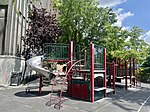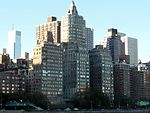Delacorte Fountain
1969 establishments in New York City1986 disestablishments in New York (state)East RiverFountains in New York CityRoosevelt Island

The Delacorte Fountain, also known as the Delacorte Geyser, was a large fountain located near the southern tip of Roosevelt Island in New York City. Dedicated in 1969, the fountain operated from 1970 until 1986 when it last broke down and was abandoned. The remains of the former fountain, including the building that housed its equipment, were demolished in 1994. The former site of the fountain is now occupied by Franklin D. Roosevelt Four Freedoms Park.
Excerpt from the Wikipedia article Delacorte Fountain (License: CC BY-SA 3.0, Authors, Images).Delacorte Fountain
New York
Geographical coordinates (GPS) Address Nearby Places Show on map
Geographical coordinates (GPS)
| Latitude | Longitude |
|---|---|
| N 40.7502 ° | E -73.9613 ° |
Address
11109 New York
New York, United States
Open on Google Maps










